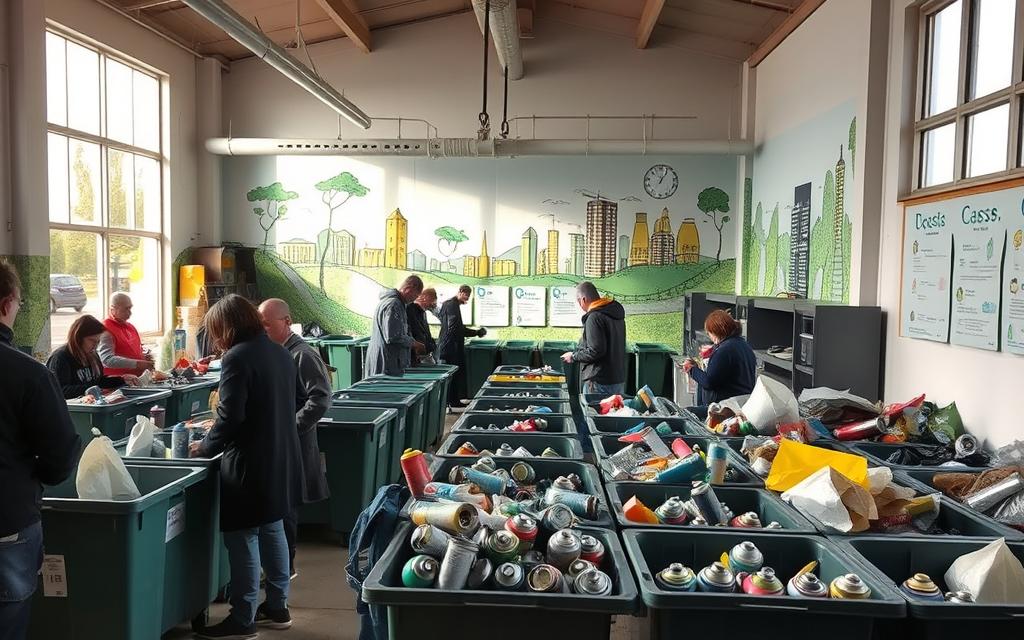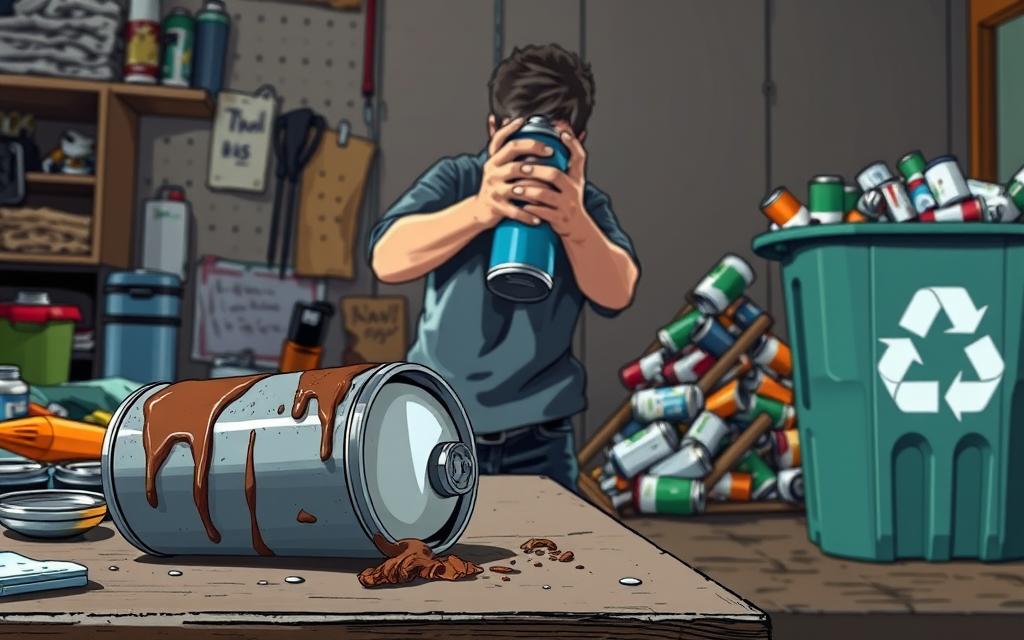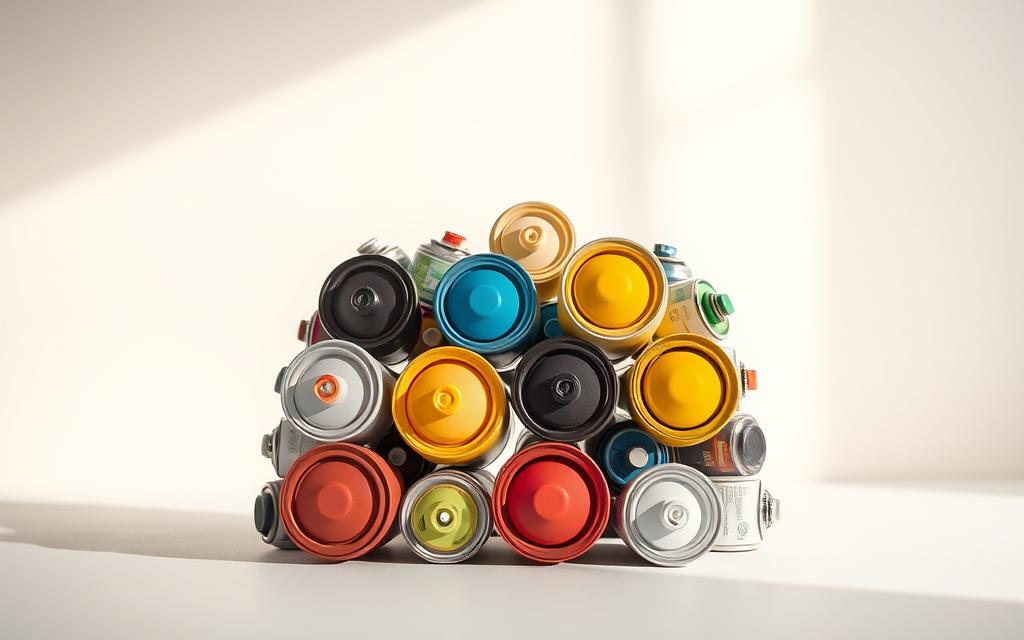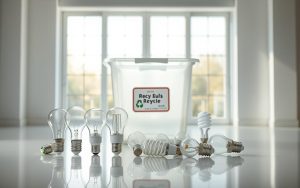Every year, the U.S. produces over 3.5 billion aerosol cans, making proper disposal a critical issue. Improper handling of these containers can lead to serious environmental hazards, including landfill explosions and leaks of hazardous materials.
Steel and aluminum aerosol cans are recyclable when handled correctly. Following EPA guidelines ensures they are processed safely, reducing risks to both people and the planet. States like California and Colorado have even implemented specific regulations to encourage proper recycling practices.
This article will guide you through the step-by-step process of safely disposing of these containers, helping you contribute to a cleaner, safer environment.
Introduction to Recycling Spray Paint Cans
Millions of pressurized cans are discarded incorrectly each year. These containers, often used for paints and solvents, pose unique challenges during disposal. The EPA classifies them as hazardous waste when they contain residual chemicals, making proper handling essential.
Aerosol cans are pressurized containers that require special care. They combine two risks: the pressurized gas inside and potentially harmful contents like paints or solvents. Mishandling these containers can lead to dangerous situations, including fires or explosions.
According to RCRA guidelines, empty cans lose their hazardous classification. This means they can be safely processed for recycling. However, 70% of aerosol cans still end up in landfills, despite their recyclable metal value. This improper disposal contributes to environmental harm and wasted resources.
Incorrect disposal can also result in regulatory fines or community hazards. For example, puncturing or crushing these containers can release toxic substances or cause fires. To avoid these risks, it’s crucial to follow proper procedures, such as ensuring the can is completely empty before disposal. Learn more about common mistakes to avoid when handling these materials.
Why Recycling Spray Paint Cans Matters
Proper disposal of pressurized containers is essential for environmental safety. In the U.S., only 30% of aerosol containers are recycled, despite an annual production of 3.5 billion. This low recycling rate contributes to significant environmental impact, including the release of harmful chemicals.
Residual propellants, such as volatile organic compounds (VOCs), can escape into the atmosphere. These chemicals contribute to smog formation, worsening air quality. Proper handling ensures these substances are contained and processed safely.

Landfills face risks from pressurized containers. When compacted, these items can explode, causing fires or releasing hazardous waste. A single landfill fire caused by these containers cost a recycling facility $1.2 million, highlighting the dangers of improper disposal.
Recycling these materials also conserves resources. For example, processing one ton of aluminum saves 14,000 kWh of energy. This reduces mining needs by 95%, making recycling a sustainable choice.
States like California and Colorado have implemented strict regulations. They ban these containers from landfills, encouraging proper recycling practices. These mandates aim to reduce risks and promote environmental responsibility.
Preparing Your Spray Paint Cans for Recycling
Proper preparation of pressurized containers ensures safe recycling. Following specific steps helps minimize risks and ensures compliance with EPA guidelines. This process involves verifying emptiness and removing non-metal components.
Ensure the Can is Completely Empty
Before recycling, make sure the container is completely empty. The EPA recommends shaking the can to check for liquid residue. If any liquid remains, use the “shake-and-spray” method to verify emptiness.
Never attempt DIY puncturing with tools like screwdrivers. A case study by Aerosolv highlights the dangers of improper puncturing, which can lead to explosions or chemical leaks. Always follow EPA’s RCRA-empty definition for regulatory compliance.
Remove Plastic Caps and Nozzles
Separate plastic caps and nozzles from the metal container. While caps are often made of #5 polypropylene, they are frequently rejected in curbside recycling programs. Check local guidelines for size restrictions on plastic recycling.
Incompatible items like plastic straws should be discarded in the trash. Rubber seals, classified as household hazardous waste (HHW), require special disposal methods. Proper separation ensures efficient recycling of the metal components.
| Component | Disposal Method |
|---|---|
| Plastic Caps | Check local recycling guidelines |
| Metal Container | Recycle if completely empty |
| Rubber Seals | Household Hazardous Waste (HHW) |
Safety Precautions When Handling Spray Paint Cans
Handling pressurized containers requires strict safety measures to prevent accidents. These items, classified as hazardous waste, pose significant risks if mishandled. Proper disposal protocols ensure workplace safety and environmental protection.

Never Puncture or Crush the Can
Attempting to puncture or crush these containers can cause them to explode. The pressurized contents can release harmful chemicals or become projectiles, leading to severe injuries. OSHA guidelines emphasize storing these items at controlled temperatures and in an upright position to minimize risks.
DIY depressurization methods are particularly dangerous. Aerosolv systems, for example, reduce workplace injuries by 89% by safely depressurizing cans. Static electricity from improper handling accounts for 23% of recycling facility fires, highlighting the need for professional equipment.
Handle Hazardous Materials with Care
Always use appropriate personal protective equipment (PPE) when dealing with these materials. Gloves, goggles, and flame-resistant clothing are essential to protect against chemical burns and other hazards. The EPA issued fines of $15,000 per incident in 2023 for improper labeling of hazardous waste.
Municipal and commercial handling protocols differ significantly. While households can follow local guidelines, commercial operations often require 55-gallon drums for safe storage and disposal. Adhering to these standards ensures compliance and reduces risks to both workers and the environment.
How to Recycle Spray Paint Cans in Your Community
Recycling pressurized containers varies by location, making it essential to understand local guidelines. Different community programs have unique rules for handling these materials. Knowing your options ensures safe and compliant disposal.

Check Local Recycling Programs
Start by researching your local program for handling pressurized containers. Use tools like Earth911’s Recycling Locator for real-time updates on nearby facilities. Municipal policies can vary widely. For example, New York City accepts these items curbside, while rural areas may require drop-off at designated centers.
Recycle Coach’s “What Goes Where” tool is another helpful resource. It provides step-by-step guidance on sorting materials for your community. When contacting waste management, ask specific questions like, “Does your MRF have aerosol-puncturing systems?” This ensures proper handling.
Household Hazardous Waste Programs
Many areas offer household hazardous waste (HHW) programs for safe disposal. According to EHS Daily Advisor, 47% of HHW facilities provide free collection for pressurized containers. These programs often include swap shops, where you can exchange unwanted paint supplies for free.
Benefits of HHW programs include reduced disposal fees and access to professional handling. For commercial operations, DOT hazardous waste manifests are required for bulk transport. This ensures compliance with federal regulations.
| Program Type | Key Features |
|---|---|
| Local Recycling | Curbside or drop-off options |
| HHW Programs | Free collection, swap shops |
Common Mistakes to Avoid When Recycling Spray Paint Cans
Many people unknowingly make errors when disposing of pressurized containers, leading to safety hazards and environmental harm. Understanding these mistakes can help ensure proper handling and compliance with regulations.
One major error is to leave cap on the container. According to Rumpke Recycling, 68% of rejected recycling loads contain uncapped aerosol cans. Caps and nozzles can interfere with sorting machines, causing operational shutdowns.

Another common issue is assuming that all bins accept these containers. Many facilities reject non-empty cans, which account for 31% of MRF shutdowns. Always verify local guidelines to avoid contamination.
Some people mistakenly believe that food-grade containers are safe for trash. This assumption is incorrect, as even these items can pose risks if not handled properly. Storing cans in hot garages can lead to pressure buildup, increasing the chance of explosions.
Attempting to depressurize yourself is highly dangerous. DIY methods can result in chemical leaks or injuries. Always rely on professional equipment for safe depressurization.
Mislabeling hazardous waste can lead to fines up to $10,000. Ensure containers are properly labeled and follow household hazardous waste (HHW) guidelines.
Here’s a quick checklist to avoid these mistakes:
- Is the container not empty? Verify emptiness before disposal.
- Are caps and nozzles removed? Separate them from the metal container.
- Is the container labeled correctly? Follow HHW protocols for hazardous materials.
By avoiding these errors, you can contribute to safer recycling practices and reduce environmental risks.
Conclusion
Safely disposing of aerosol containers is a critical step toward protecting our environment. Always ensure the can is completely empty and never attempt to puncture or crush it. Verify your local recycling rules to avoid contamination and ensure compliance.
For updates on regulations, visit the EPA’s Household Hazardous Waste page. Take action today by scheduling a pickup through your community program. Corporate responsibility is also growing, with the EPA aiming for a 50% recycling rate by 2030.
Remember the safety mantra: “When in doubt, HHW routes it out!” For more tips on how to safely dispose of aerosol cans, explore our detailed guide. Together, we can make an environmentally friendly impact.







